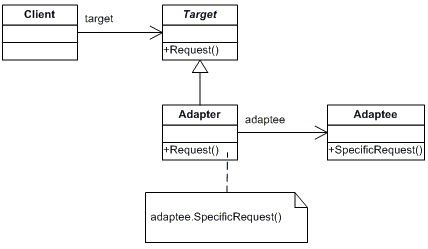Adapter
Contents
Adapter Design Pattern
Adapter, a Structural Pattern and also referred to as a wrapper, is most commonly used when you want to reuse a class to work with a target class but are constrained by incompatible interfaces. The idea is to convert the interface of a reusable class into an interface that your classes expect.
A good analogy for the Adapter pattern would be the adapter's commonly used to convert the voltage of Canadian/U.S made appliances to be used in different countries. In this case, the appliance (Target) is using the adapter (Adapter) to reuse the socket (Adaptee) already in place.
There are two specific types of adapter patterns - object adapter pattern and class adapter pattern. The latter uses multiple inheritance whereas the former uses an instance of the reuseable class it wants to adapt. Between the two, object adapter pattern is the favored one due to the fact that popular languages such as Java do not support multiple inheritance.
Object Adapter Pattern
This adapter pattern uses an instance of the class it wraps. By using an instance, methods belonging to the wrapped object can be invoked.
Class Adapter Pattern
This adapter pattern uses multiple inheritance as a means to wrap the reusable class and use its functionality.
Adapter UML Diagram
UML diagram example of the Adapter pattern. Specifically, the class adapter pattern
Image source: http://www.dofactory.com/Patterns/Diagrams/adapter.gif Copyright 2001 - 2007 Data & Object Factory.
Code Examples
References
Other
--Rueen 19:41, 17 January 2007 (EST)
